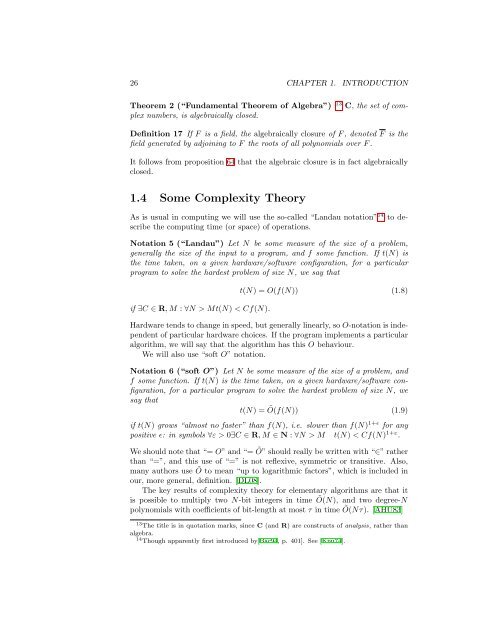Contents - Student subdomain for University of Bath
Contents - Student subdomain for University of Bath
Contents - Student subdomain for University of Bath
You also want an ePaper? Increase the reach of your titles
YUMPU automatically turns print PDFs into web optimized ePapers that Google loves.
26 CHAPTER 1. INTRODUCTION<br />
Theorem 2 (“Fundamental Theorem <strong>of</strong> Algebra”) 13 C, the set <strong>of</strong> complex<br />
numbers, is algebraically closed.<br />
Definition 17 If F is a field, the algebraically closure <strong>of</strong> F , denoted F is the<br />
field generated by adjoining to F the roots <strong>of</strong> all polynomials over F .<br />
It follows from proposition 64 that the algebraic closure is in fact algebraically<br />
closed.<br />
1.4 Some Complexity Theory<br />
As is usual in computing we will use the so-called “Landau notation” 14 to describe<br />
the computing time (or space) <strong>of</strong> operations.<br />
Notation 5 (“Landau”) Let N be some measure <strong>of</strong> the size <strong>of</strong> a problem,<br />
generally the size <strong>of</strong> the input to a program, and f some function. If t(N) is<br />
the time taken, on a given hardware/s<strong>of</strong>tware configuration, <strong>for</strong> a particular<br />
program to solve the hardest problem <strong>of</strong> size N, we say that<br />
if ∃C ∈ R, M : ∀N > Mt(N) < Cf(N).<br />
t(N) = O(f(N)) (1.8)<br />
Hardware tends to change in speed, but generally linearly, so O-notation is independent<br />
<strong>of</strong> particular hardware choices. If the program implements a particular<br />
algorithm, we will say that the algorithm has this O behaviour.<br />
We will also use “s<strong>of</strong>t O” notation.<br />
Notation 6 (“s<strong>of</strong>t O”) Let N be some measure <strong>of</strong> the size <strong>of</strong> a problem, and<br />
f some function. If t(N) is the time taken, on a given hardware/s<strong>of</strong>tware configuration,<br />
<strong>for</strong> a particular program to solve the hardest problem <strong>of</strong> size N, we<br />
say that<br />
t(N) = Õ(f(N)) (1.9)<br />
if t(N) grows “almost no faster” than f(N), i.e. slower than f(N) 1+ɛ <strong>for</strong> any<br />
positive ɛ: in symbols ∀ε > 0∃C ∈ R, M ∈ N : ∀N > M t(N) < Cf(N) 1+ε .<br />
We should note that “= O” and “= Õ” should really be written with “∈” rather<br />
than “=”, and this use <strong>of</strong> “=” is not reflexive, symmetric or transitive. Also,<br />
many authors use Õ to mean “up to logarithmic factors”, which is included in<br />
our, more general, definition. [DL08].<br />
The key results <strong>of</strong> complexity theory <strong>for</strong> elementary algorithms are that it<br />
is possible to multiply two N-bit integers in time Õ(N), and two degree-N<br />
polynomials with coefficients <strong>of</strong> bit-length at most τ in time Õ(Nτ). [AHU83]<br />
13 The title is in quotation marks, since C (and R) are constructs <strong>of</strong> analysis, rather than<br />
algebra.<br />
14 Though apparently first introduced by[Bac94, p. 401]. See [Knu74].












![[Luyben] Process Mod.. - Student subdomain for University of Bath](https://img.yumpu.com/26471077/1/171x260/luyben-process-mod-student-subdomain-for-university-of-bath.jpg?quality=85)



